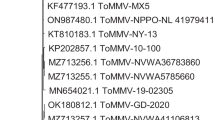Abstract
A putative new emaravirus, named “ailanthus crinkle leaf-associated emaravirus” (ACrLaV), was detected in Ailanthus altissima with severe crinkle symptoms by RNA-Seq and RT-PCR. Four viral segments associated with ACrLaV were identified and fully sequenced, except for a few nucleotides at the genomic termini. The RNA-dependent RNA polymerase (RNA1), glycoprotein (RNA2), nucleocapsid protein (RNA3), and movement protein (RNA4), showed 26.5%-57%, 17%-49.9%, 14.4%-40.4%, and 14.1%-65.9% amino acid sequence identity, respectively, to those of known emaraviruses. All four ACrLaV genomic RNA segments are most closely related to those of common oak ringspot-associated virus from Germany, as supported by sequence comparisons and phylogenetic analysis. ACrLaV is considered a distinct member of the genus Emaravirus, and this is the first report of an emaravirus in A. altissima.


Similar content being viewed by others
References
Zhang MM, Zhen CH, Liu CP, Xu ZH, Du KJ (2021) Progress and prospect of the research on Ailanthus altissima. Hebei For Sci Technol 02:49–53
Niu YB, Yao M, Wang FD (2011) Identification of the pathogenic virus on Ailanthus altissima. Acta Phytopathol Sin 41(4):437–440
Gu QS, Roggero P, Ciuffo M, Lenzi R (2003) The research on a Potyvirus causing Ailanthus mosaic and ringspot. J Yunnan Agric Univ 18(S1):115–116
Elbeaino T, Digiaro M, Mielke-Ehret N, Muehlbach HP, Martelli GP (2018) ICTV virus taxonomy profile: Fimoviridae. J Gen Virol 99(11):1478–1479
Mielke N, Muehlbach HP (2007) A novel, multipartite, negative-strand RNA virus is associated with the ring spot disease of European mountain ash (Sorbus aucuparia L.). J Gen Virol 88(4):1337–1346
Kubota K, Usugi T, Tomitaka Y, Shimomoto Y, Takeuchi S, Kadono F, Yanagisawa H, Chiaki Y, Tsuda S (2020) Perilla mosaic virus is a highly divergent emaravirus transmitted by Shevtchenkella sp. (Acari: Eriophyidae). Phytopathology 110(7):1352–1361
Coutts BA, Cox BA, Thomas GJ, Jones RAC (2014) First report of wheat mosaic virus infecting wheat in Western Australia. Plant Dis 98(2):285
Elbeaino T, Digiaro M, Uppala M, Sudini H (2014) Deep sequencing of pigeonpea sterility mosaic virus discloses five RNA segments related to emaraviruses. Virus Res 188:27–31
Hassan M, DiBello PL, Keller KE, Martin RR, Sabanadzovic S, Tzanetakis IE (2017) A new, widespread emaravirus discovered in blackberry. Virus Res 235:1–5
Zheng Y, Navarro B, Wang G, Wang Y, Yang Z, Xu W, Zhu C, Wang L, Di Serio FD, Hong N (2017) Actinidia chlorotic ring spot associated virus: a novel emaravirus infecting kiwifruit plants. Mol Plant Pathol 18(4):569–581
Yang C, Zhang S, Han T, Fu J, Di Serio F, Cao M (2019) Identification and characterization of a novel emaravirus associated with jujube (Ziziphus jujuba Mill.) yellow mottle disease. Front Microbiol 10:1417
Liu HZ, Wang GP, Yang ZK, Wang YX, Zhang Z, Li LH (2020) Identification and characterization of a pear chlorotic leaf spot-associated virus, a novel emaravirus associated with a severe disease of pear trees in China. Plant Dis 104(11):2786–2798
Wang YQ, Song Y, Cao MJ, Cheng Q, Wu JX, Hu T (2020) Identification of a novel emaravirus infecting lilac through next-generation sequencing. J Integr Agric 19(8):2064–2071
Wu X, Liu J, Cheng X (2020) First report of Camellia japonica Associated emaravirus 1 associated with camellia leaf ringspot and flower color-breaking disease in China. Plant Dis 104(12):3271
Fan X, Li C, Zhang Z, Ren F, Hu G, Shen H, Zhang B, Dong Y (2021) Identification and characterization of a novel emaravirus from grapevine showing chlorotic mottling symptoms. Front Microbiol 12:694601
Afiahayati SK, Sakakibara Y (2015) MetaVelvet-SL: an extension of the Velvet assembler to a de novo metagenomic assembler utilizing supervised learning. DNA Res 22(1):69–77
Amroun A, Priet S, de Lamballerie X, Quérat G (2017) Bunyaviridae RdRps: structure, motifs, and RNA synthesis machinery. Crit Rev Microbiol 43(6):753–778
Kormelink R, Verchot J, Tao X, Desbiez C (2021) The Bunyavirales: the plant-infecting counterparts. Viruses 13(5):842
Tamura K, Stecher G, Kumar S (2021) MEGA11: molecular evolutionary genetics analysis version 11. Mol Biol Evol 38(7):3022–3027
Acknowledgements
We would like to thank Dr. Zhenguo Du of Fujian Agriculture and Forestry University for useful discussion on the genomic constitution.
Funding
This work was supported by funds from the Natural Science Foundation of Liaoning Province (2021-MS-341) and the Program for Young and Middle-Aged Scientific and Technological Innovation Talents of Shenyang City (RC210161).
Author information
Authors and Affiliations
Corresponding author
Ethics declarations
Conflict of interest
The authors declare no conflict of interest.
Ethical approval
This article does not contain any experiments involving humans or animals, and no ethical approval was required.
Additional information
Handling Editor: Massimo Turina.
Publisher's Note
Springer Nature remains neutral with regard to jurisdictional claims in published maps and institutional affiliations.
Supplementary Information
Below is the link to the electronic supplementary material.
Rights and permissions
Springer Nature or its licensor holds exclusive rights to this article under a publishing agreement with the author(s) or other rightsholder(s); author self-archiving of the accepted manuscript version of this article is solely governed by the terms of such publishing agreement and applicable law.
About this article
Cite this article
An, W., Li, C., Zhang, S. et al. A putative new emaravirus isolated from Ailanthus altissima (Mill.) Swingle with severe crinkle symptoms in China. Arch Virol 167, 2403–2405 (2022). https://doi.org/10.1007/s00705-022-05569-6
Received:
Accepted:
Published:
Issue Date:
DOI: https://doi.org/10.1007/s00705-022-05569-6




